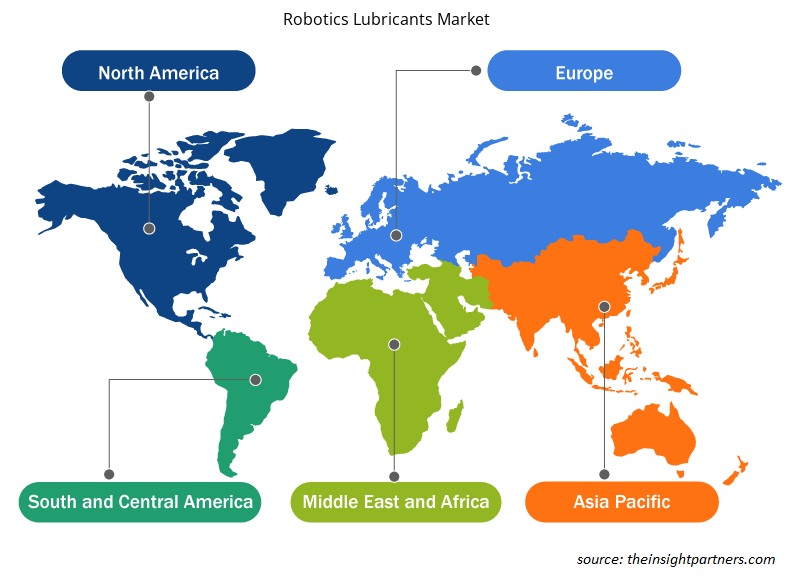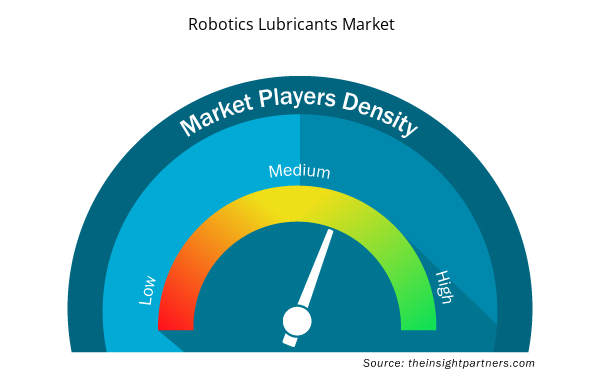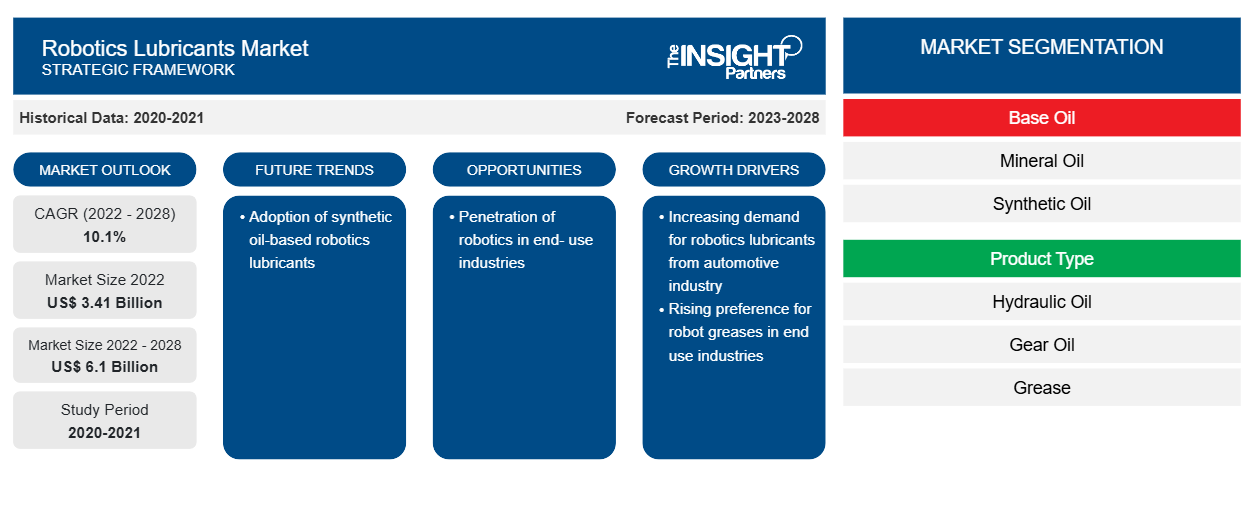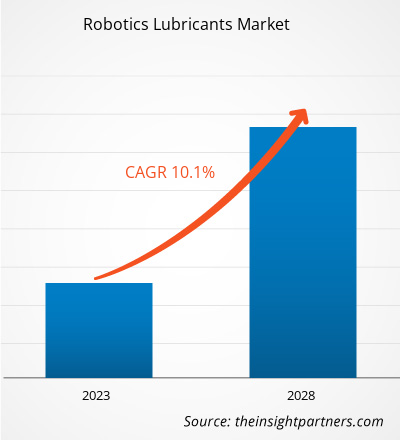[Informe de investigación] Se espera que el tamaño del mercado de lubricantes robóticos crezca de US$ 3.413,72 millones en 2022 a US$ 6.095,41 millones en 2028; se estima que registrará una CAGR del 10,1% de 2022 a 2028.
ANÁLISIS DE MERCADO
Los lubricantes se utilizan para reducir la fricción entre superficies y el calor generado, aumentando así la vida útil de las superficies involucradas. Los robots industriales participan en la manipulación, el montaje y la dosificación de materiales, por lo que quedan expuestos a los efectos del desgaste y la corrosión. Los lubricantes para robótica se desarrollan para ayudar a reducir el tiempo de inactividad de los robots industriales e incidir positivamente en la calidad, los costes y la eficiencia del proceso de fabricación. Los lubricantes consisten en una variedad de fluidos para soportar condiciones extremas. La grasa es un lubricante muy utilizado para operaciones robóticas.
IMPULSORES DEL CRECIMIENTO Y DESAFÍOS
La creciente demanda de lubricantes para robótica en las industrias de uso final ha ayudado al crecimiento del mercado de lubricantes para robótica . En el sector manufacturero, un lubricante para robótica es uno de los componentes clave que ayudan a que un equipo funcione con la máxima confiabilidad y con la máxima eficiencia. Las grasas, los aceites hidráulicos y los aceites para engranajes se utilizan en varias industrias de uso final, incluidas la automotriz, la eléctrica y electrónica, la de alimentos y bebidas, la logística y la fabricación de metales y maquinaria. La grasa para robótica contiene aceite base, como aceite mineral o aceite sintético, espesante y aditivos, que imparten cualidades distintivas al producto. Las grasas poseen varias propiedades, como capacidad de sellado, baja tendencia a las fugas, protección contra la corrosión y manejo de cargas pesadas. Varias grasas para robots disponibles comercialmente son de grado alimenticio y cumplen con ciertos estándares internacionales para industrias específicas, como la de alimentos y bebidas y la médica y de atención médica. La grasa se degrada debido a la fricción y la exposición a temperaturas extremas hasta que sus niveles de viscosidad son insuficientes para lubricar eficazmente los componentes mecánicos internos. El engrase de robots es una parte integral del mantenimiento de la eficiencia general de los robots y los componentes robóticos. La frecuencia recomendada para el engrase de robots varía según la marca y el modelo. Por lo tanto, las ventajas de las grasas sobre otros lubricantes y la preferencia por las grasas para robots de las industrias de uso final están impulsando el mercado de lubricantes para robótica. Sin embargo, las fluctuaciones en las condiciones económicas mundiales llevaron a un aumento en los costos de aditivos, bases, transporte y fabricación. Varios fabricantes fueron testigos de la presión inflacionaria, así como del suministro de aditivos para lubricantes en toda la cadena de suministro de lubricantes. En 2022, los precios del aceite base en los EE. UU. aumentaron de US $ 2 por galón a US $ 5 por galón. Además, en 2022, FUCHS Lubricants Co anunció un aumento de precios del 8-12% para su cartera de aditivos para lubricantes, que se implementó a partir de octubre de 2022. Además, en 2022, Ergon Inc aumentó los precios del aceite base nafténico. Sin embargo, en 2023, Chevron Corporation anunció una disminución de US $ 0,20 a US $ 0,50 en el precio del aceite base. Por lo tanto, la fluctuación en los precios de las materias primas está frenando el crecimiento del mercado de lubricantes para robótica.
Personalice este informe según sus necesidades
Obtendrá personalización en cualquier informe, sin cargo, incluidas partes de este informe o análisis a nivel de país, paquete de datos de Excel, así como también grandes ofertas y descuentos para empresas emergentes y universidades.
- Obtenga las principales tendencias clave del mercado de este informe.Esta muestra GRATUITA incluirá análisis de datos, desde tendencias del mercado hasta estimaciones y pronósticos.
SEGMENTACIÓN Y ALCANCE DEL INFORME
El "Análisis del mercado mundial de lubricantes para robótica hasta 2028" es un estudio especializado y profundo centrado principalmente en las tendencias y oportunidades de crecimiento del mercado mundial de lubricantes para robótica. El informe tiene como objetivo proporcionar una descripción general del mercado mundial de lubricantes para robótica con una segmentación detallada del mercado por aceite base, tipo de producto, industria de uso final y geografía. El mercado mundial de lubricantes para robótica ha experimentado un alto crecimiento en el pasado reciente y se espera que continúe con esta tendencia durante el período de pronóstico. El informe proporciona estadísticas clave sobre el consumo de lubricantes para robótica en todo el mundo junto con su demanda en las principales regiones y países. Además, el informe proporciona la evaluación cualitativa de varios factores que afectan el desempeño del mercado de lubricantes para robótica en las principales regiones y países. El informe también incluye un análisis exhaustivo de los principales actores del mercado de lubricantes para robótica y sus desarrollos estratégicos clave. También se incluyen varios análisis sobre la dinámica del mercado para ayudar a identificar los factores impulsores clave, las tendencias del mercado y las oportunidades lucrativas del mercado de lubricantes para robótica que, a su vez, ayudarían a identificar los principales bolsillos de ingresos.
Además, el análisis del ecosistema y el análisis de las cinco fuerzas de Porter proporcionan una visión de 360 grados del mercado global de lubricantes robóticos, lo que ayuda a comprender toda la cadena de suministro y varios factores que afectan el crecimiento del mercado.
ANÁLISIS SEGMENTAL
El mercado global de lubricantes para robótica está segmentado en función del aceite base, el tipo de producto y la industria de uso final. Según el aceite base, el mercado de lubricantes para robótica se segmenta en aceite mineral, sintético y otros. Según el tipo de producto, el mercado se clasifica en aceite hidráulico, aceite para engranajes y grasa. Según la industria de uso final, el mercado se clasifica en industrias de automoción, alimentación y bebidas, médica y sanitaria, eléctrica y electrónica, metales y otras industrias manufactureras.
Basado en aceite mineral, el aceite mineral representó una importante participación en el mercado de lubricantes para robótica. Muchos fabricantes de lubricantes proporcionan lubricantes multipropósito para aplicaciones en componentes de engranajes robóticos, cadenas, cojinetes y conexiones roscadas. Castrol Ltd ofrece aceites para engranajes a base de minerales, incluidos Optigear ALR 320, Optigear BM 100 y Alpha SP 320, para todas o algunas aplicaciones axiales robóticas. Sobre la base del tipo de producto, el segmento de grasa lideró el mercado de lubricantes para robótica con una mayor participación de mercado. Sobre la base del uso final, la industria automotriz representó una importante participación en el mercado de lubricantes para robótica. Se espera que el segmento eléctrico y electrónico registre la CAGR más rápida durante el período de pronóstico.
ANÁLISIS REGIONAL
El informe proporciona una descripción detallada del mercado mundial de lubricantes para robótica con respecto a cinco regiones principales, a saber, América del Norte, Europa, Asia-Pacífico (APAC), Oriente Medio y África (MEA) y América del Sur y Central. Asia Pacífico representó una parte importante del mercado y se valoró en más de US$ 1.9 mil millones en 2022. La región de Asia Pacífico es un mercado destacado para los lubricantes para robótica debido al crecimiento en los sectores automotriz y electrónico y al aumento de la industrialización, lo que lleva a una mayor demanda del sector manufacturero. También se espera que Europa sea testigo de un crecimiento considerable que alcance más de US$ 1.2 mil millones en 2028, atribuido a la creciente utilización de lubricantes para robótica en la industria eléctrica y electrónica. Se espera que América del Norte crezca a una CAGR de alrededor del 9% entre 2022 y 2028.
DESARROLLOS DE LA INDUSTRIA Y OPORTUNIDADES FUTURAS
Se descubrió que las asociaciones, las adquisiciones y los lanzamientos de nuevos productos eran las principales estrategias adoptadas por los actores que operan en el mercado global de lubricantes robóticos.
En abril de 2023, la empresa FUCHS lanzó al mercado RENOLIT ROBO-G 0, una grasa para la lubricación de robots. Se trata de una grasa semilíquida de extrema presión (EP) a base de jabón complejo de litio y aceite mineral. El producto está destinado a su aplicación en engranajes de precisión, como robots industriales, máquinas herramienta y mesas redondas.
Perspectivas regionales del mercado de lubricantes para robótica
Los analistas de Insight Partners explicaron en detalle las tendencias y los factores regionales que influyen en el mercado de lubricantes para robótica durante el período de pronóstico. Esta sección también analiza los segmentos y la geografía del mercado de lubricantes para robótica en América del Norte, Europa, Asia Pacífico, Oriente Medio y África, y América del Sur y Central.

- Obtenga datos regionales específicos para el mercado de lubricantes robóticos
Alcance del informe sobre el mercado de lubricantes para robótica
| Atributo del informe | Detalles |
|---|---|
| Tamaño del mercado en 2022 | US$ 3,41 mil millones |
| Tamaño del mercado en 2028 | 6.100 millones de dólares estadounidenses |
| CAGR global (2022-2028) | 10,1% |
| Datos históricos | 2020-2021 |
| Período de pronóstico | 2023-2028 |
| Segmentos cubiertos | Por aceite base
|
| Regiones y países cubiertos | América del norte
|
| Líderes del mercado y perfiles de empresas clave |
|
Densidad de actores del mercado de lubricantes para robótica: comprensión de su impacto en la dinámica empresarial
El mercado de lubricantes para robótica está creciendo rápidamente, impulsado por la creciente demanda de los usuarios finales debido a factores como la evolución de las preferencias de los consumidores, los avances tecnológicos y una mayor conciencia de los beneficios del producto. A medida que aumenta la demanda, las empresas amplían sus ofertas, innovan para satisfacer las necesidades de los consumidores y aprovechan las tendencias emergentes, lo que impulsa aún más el crecimiento del mercado.
La densidad de actores del mercado se refiere a la distribución de las empresas o firmas que operan dentro de un mercado o industria en particular. Indica cuántos competidores (actores del mercado) están presentes en un espacio de mercado determinado en relación con su tamaño o valor total de mercado.
Las principales empresas que operan en el mercado de lubricantes robóticos son:
- Miller-Stephenson Inc
- Shell Internacional BV
- Fuchs Petrolub SE
- Compañía BP Plc
- Compañía Idemitsu Kosan Ltd.
Descargo de responsabilidad : Las empresas enumeradas anteriormente no están clasificadas en ningún orden particular.

- Obtenga una descripción general de los principales actores clave del mercado de lubricantes robóticos
IMPACTO DEL COVID/IMPACTO DEL ESCENARIO GEOPOLÍTICO/IMPACTO DE LA RECESIÓN
Los confinamientos, las restricciones de viaje y los cierres de empresas debido a la pandemia de COVID-19 afectaron negativamente a las economías e industrias de varios países de América del Norte, Europa, Asia Pacífico (APAC), América del Sur y Central, y Oriente Medio y África (MEA). La crisis perturbó las cadenas de suministro globales, las actividades de fabricación, los cronogramas de entrega y las ventas de productos esenciales y no esenciales. Varias empresas anunciaron posibles retrasos en las entregas de productos y una caída en las ventas futuras de sus productos en 2020. Además, las prohibiciones de viajes internacionales impuestas por varios gobiernos en Europa, Asia Pacífico y América del Norte obligaron a varias empresas a interrumpir sus planes de colaboración y asociación. Todos estos factores obstaculizaron la industria de productos químicos y materiales en 2020 y principios de 2021, lo que restringió el crecimiento de varios mercados relacionados con esta industria, incluido el mercado de lubricantes robóticos.
Antes del brote de COVID-19, el mercado de lubricantes para robótica estaba impulsado principalmente por la creciente demanda de las industrias automotriz y electrónica. Sin embargo, en 2020, varias industrias tuvieron que desacelerar sus operaciones debido a interrupciones en las cadenas de valor causadas por el cierre de fronteras nacionales e internacionales. La pandemia de COVID-19 interrumpió la cadena de suministro de materias primas clave y alteró los procesos de fabricación debido a las restricciones impuestas por las autoridades gubernamentales en varios países. Dichos factores redujeron la producción de lubricantes para robótica.
PANORAMA COMPETITIVO Y EMPRESAS CLAVE
Algunos de los actores clave que operan en el mercado de lubricantes robóticos incluyen a Miller-Stephenson Inc, Shell International BV, Fuchs, Petrolub SE, BP Plc, Idemitsu Kosan Co Ltd, Chemie-Technik GmbH, Anand Engineer Pvt Ltd, Kluber Lubrication GmbH & Co KG y Schaeffler Austria GmbH, entre otros.
- Análisis histórico (2 años), año base, pronóstico (7 años) con CAGR
- Análisis PEST y FODA
- Tamaño del mercado Valor/volumen: global, regional, nacional
- Industria y panorama competitivo
- Conjunto de datos de Excel



Report Coverage
Revenue forecast, Company Analysis, Industry landscape, Growth factors, and Trends

Segment Covered
This text is related
to segments covered.

Regional Scope
North America, Europe, Asia Pacific, Middle East & Africa, South & Central America

Country Scope
This text is related
to country scope.
Preguntas frecuentes
The automotive segment held the largest share of the market in 2022. Automotive assembly lines encompass several challenges such as potential for injury, handling of high load components, slow production time, and quality inspection. Therefore, automotive industry deploys robots to overcome aforementioned challenges.
In 2022, Asia Pacific held the largest revenue share of the global robotics lubricants market is expected to register the highest CAGR from 2022 to 2028. The robotics lubricants market growth in Japan, China, South Korea, Singapore, Taiwan, and Vietnam is attributed to growing manufacturing sector in the region. Asia Pacific is manufacturing hub for automotive and electronics industries with China, Japan, and South Korea playing major role in installation of robotics for manufacturing process.
Asia Pacific is estimated to register the highest CAGR in the global robotics lubricants market over the forecast period. The growth of the robotics lubricants market in Asia-Pacific is driven by rising demand for robotics lubricants from various end-use industries such as automotive, food and beverage, medical and healthcare, electrical and electronics, metals, and other manufacturing industries.
The major players operating in the global robotics lubricants market are Miller-Stephenson Inc, Shell International BV, Fuchs Petrolub SE, BP Plc, Idemitsu Kosan Co Ltd, Chemie-Technik GmbH, Anand Engineer Pvt Ltd, Kluber Lubrication GmbH & Co KG, and Schaeffler Austria GmbH.
The mineral oil segment held the largest market share. Mineral oil is the most commonly used base oil in lubricant formulations. Paraffinic mineral oils possess several advantages such as high viscosity index and high flash point.
The grease segment held the largest share of the market in 2022. Robotic greases generally consist of mineral or semi-synthetic base oil with viscosity ranging from 40 to 175 centistokes. NLGI (National Lubricating Grease Institute) 0 or NLGI 00 greases are generally preferred for application in robotic joints.
Trends and growth analysis reports related to Chemicals and Materials : READ MORE..
The List of Companies - Robotics Lubricants Market
- Miller-Stephenson Inc
- Shell International BV
- Fuchs Petrolub SE
- BP Plc
- Idemitsu Kosan Co Ltd
- Chemie-Technik GmbH
- Anand Engineer Pvt Ltd
- Kluber Lubrication GmbH & Co KG
- Schaeffler Austria GmbH
- ASV Multichemie Pvt Ltd
The Insight Partners performs research in 4 major stages: Data Collection & Secondary Research, Primary Research, Data Analysis and Data Triangulation & Final Review.
- Data Collection and Secondary Research:
As a market research and consulting firm operating from a decade, we have published and advised several client across the globe. First step for any study will start with an assessment of currently available data and insights from existing reports. Further, historical and current market information is collected from Investor Presentations, Annual Reports, SEC Filings, etc., and other information related to company’s performance and market positioning are gathered from Paid Databases (Factiva, Hoovers, and Reuters) and various other publications available in public domain.
Several associations trade associates, technical forums, institutes, societies and organization are accessed to gain technical as well as market related insights through their publications such as research papers, blogs and press releases related to the studies are referred to get cues about the market. Further, white papers, journals, magazines, and other news articles published in last 3 years are scrutinized and analyzed to understand the current market trends.
- Primary Research:
The primarily interview analysis comprise of data obtained from industry participants interview and answers to survey questions gathered by in-house primary team.
For primary research, interviews are conducted with industry experts/CEOs/Marketing Managers/VPs/Subject Matter Experts from both demand and supply side to get a 360-degree view of the market. The primary team conducts several interviews based on the complexity of the markets to understand the various market trends and dynamics which makes research more credible and precise.
A typical research interview fulfils the following functions:
- Provides first-hand information on the market size, market trends, growth trends, competitive landscape, and outlook
- Validates and strengthens in-house secondary research findings
- Develops the analysis team’s expertise and market understanding
Primary research involves email interactions and telephone interviews for each market, category, segment, and sub-segment across geographies. The participants who typically take part in such a process include, but are not limited to:
- Industry participants: VPs, business development managers, market intelligence managers and national sales managers
- Outside experts: Valuation experts, research analysts and key opinion leaders specializing in the electronics and semiconductor industry.
Below is the breakup of our primary respondents by company, designation, and region:

Once we receive the confirmation from primary research sources or primary respondents, we finalize the base year market estimation and forecast the data as per the macroeconomic and microeconomic factors assessed during data collection.
- Data Analysis:
Once data is validated through both secondary as well as primary respondents, we finalize the market estimations by hypothesis formulation and factor analysis at regional and country level.
- Macro-Economic Factor Analysis:
We analyse macroeconomic indicators such the gross domestic product (GDP), increase in the demand for goods and services across industries, technological advancement, regional economic growth, governmental policies, the influence of COVID-19, PEST analysis, and other aspects. This analysis aids in setting benchmarks for various nations/regions and approximating market splits. Additionally, the general trend of the aforementioned components aid in determining the market's development possibilities.
- Country Level Data:
Various factors that are especially aligned to the country are taken into account to determine the market size for a certain area and country, including the presence of vendors, such as headquarters and offices, the country's GDP, demand patterns, and industry growth. To comprehend the market dynamics for the nation, a number of growth variables, inhibitors, application areas, and current market trends are researched. The aforementioned elements aid in determining the country's overall market's growth potential.
- Company Profile:
The “Table of Contents” is formulated by listing and analyzing more than 25 - 30 companies operating in the market ecosystem across geographies. However, we profile only 10 companies as a standard practice in our syndicate reports. These 10 companies comprise leading, emerging, and regional players. Nonetheless, our analysis is not restricted to the 10 listed companies, we also analyze other companies present in the market to develop a holistic view and understand the prevailing trends. The “Company Profiles” section in the report covers key facts, business description, products & services, financial information, SWOT analysis, and key developments. The financial information presented is extracted from the annual reports and official documents of the publicly listed companies. Upon collecting the information for the sections of respective companies, we verify them via various primary sources and then compile the data in respective company profiles. The company level information helps us in deriving the base number as well as in forecasting the market size.
- Developing Base Number:
Aggregation of sales statistics (2020-2022) and macro-economic factor, and other secondary and primary research insights are utilized to arrive at base number and related market shares for 2022. The data gaps are identified in this step and relevant market data is analyzed, collected from paid primary interviews or databases. On finalizing the base year market size, forecasts are developed on the basis of macro-economic, industry and market growth factors and company level analysis.
- Data Triangulation and Final Review:
The market findings and base year market size calculations are validated from supply as well as demand side. Demand side validations are based on macro-economic factor analysis and benchmarks for respective regions and countries. In case of supply side validations, revenues of major companies are estimated (in case not available) based on industry benchmark, approximate number of employees, product portfolio, and primary interviews revenues are gathered. Further revenue from target product/service segment is assessed to avoid overshooting of market statistics. In case of heavy deviations between supply and demand side values, all thes steps are repeated to achieve synchronization.
We follow an iterative model, wherein we share our research findings with Subject Matter Experts (SME’s) and Key Opinion Leaders (KOLs) until consensus view of the market is not formulated – this model negates any drastic deviation in the opinions of experts. Only validated and universally acceptable research findings are quoted in our reports.
We have important check points that we use to validate our research findings – which we call – data triangulation, where we validate the information, we generate from secondary sources with primary interviews and then we re-validate with our internal data bases and Subject matter experts. This comprehensive model enables us to deliver high quality, reliable data in shortest possible time.


 Obtenga una muestra gratuita de este informe
Obtenga una muestra gratuita de este informe